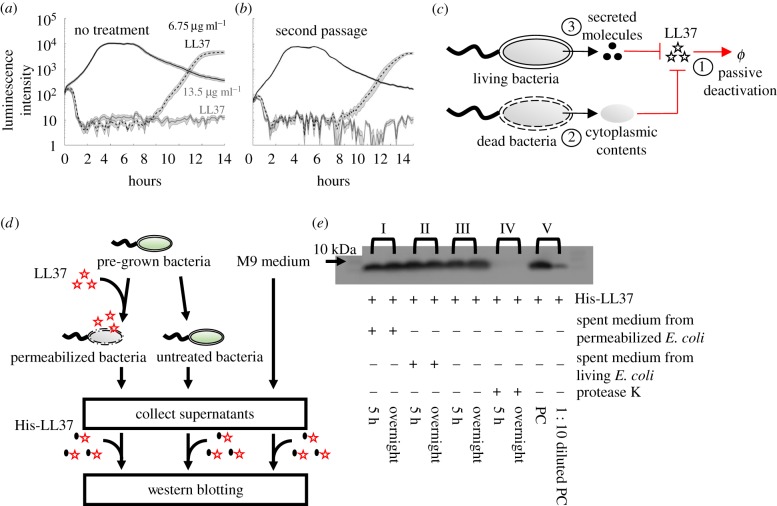Figure 1.
Escherichia coli population tolerates LL37 through a mechanism that is not heritable or degradation. (a) Population dynamics of E. coli are tracked using their luminescence intensity. Bacteria treated with LL37 at two concentrations (black dashed line and grey line) demonstrate initial killing (before 7–8 h) compared with the one without treatment (black solid line). However, the bacterial population treated with 6.75 µg ml−1 of LL37 recovers after around 8 h. Shaded error bars are standard error of the mean (s.e.m.) from N = 11. See Methods (§4.2). (b) Recovered bacteria from LL37 treatment at 6.75 µg ml−1 (a, black dashed line) are collected and grown overnight. The second passage of recovered bacteria is treated with LL37 at two concentrations (black dashed line and grey line) following the same protocol as in (a). The second passage of bacteria exhibits similar recovery after inhibition, suggesting that genetic mutations do not cause the recovery in our system. Shaded error bars are s.e.m. from N = 12. See Methods (§4.2). (c) The schematic shows possible mechanisms that may reduce the antimicrobial activity of LL37 in bacterial culture: ①. Natural degradation or self-aggregation may alter and mask functional domains of LL37. ②. Permeabilized bacterial cells may release intracellular contents that degrade or inactivate LL37. ③. Live bacteria may secrete molecules that degrade or inactivate LL37. (d) A flow chart illustrates the experiments that investigate stability (①) of His-LL37 in medium and the degradation (② and ③) of His-LL37 in spent medium from permeabilized or live bacteria (e). Specifically, bacterial cells are permeabilized by LL37, and cytoplasmic contents in the spent medium are collected by centrifugation (left). Secreted molecules are collected by removing untreated bacteria from the medium (middle). As a control, medium without cells is included (right). His-LL37 is incubated in the spent medium or fresh medium and subjected to western blotting. See electronic supplementary material, method S2. (e) Quantification of the relative amount of His-labelled LL37 (His-LL37). We treat His-LL37 with the collected spent medium (d) for 5 h or overnight to assess its degradation. The relative amount of His-LL37 is quantified using the band intensity from western blotting. His-LL37 incubated in spent medium from permeabilized bacteria (I) or live bacteria (II) does not show a reduction in band intensity. Furthermore, the relative amount of His-LL37 does not change over time in medium without bacteria, which suggests that LL37 does not naturally degrade in the medium (III). Proteinase K retains proteolytic activity in our reaction condition (IV). Western blotting is sensitive to a 10-fold decrease in the amount of His-LL37 (V). See replicate of western blotting results in electronic supplementary material, figure S4a. See also electronic supplementary material, method S2. (Online version in colour.)

